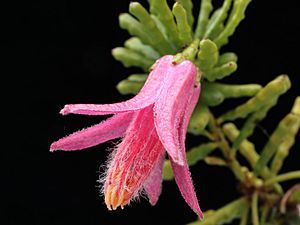Philotheca coccinea facts for kids
Quick facts for kids Philotheca coccinea |
|
|---|---|
 |
|
| Scientific classification | |
| Genus: |
Philotheca
|
| Species: |
coccinea
|
| Synonyms | |
|
Eriostemon coccineus C.A.Gardner |
|
Philotheca coccinea is a beautiful flowering plant. It belongs to the Rutaceae family, which also includes citrus trees. This plant is special because it grows naturally only in Western Australia. It is a shrub with unique club-shaped leaves. Its bright red or pink flowers grow one by one from where the leaves meet the stem.
Contents
What Does the Plant Look Like?
Philotheca coccinea is a shrub that can grow from about 30 centimeters (1 foot) to 1.5 meters (5 feet) tall. Its branches have small, bumpy spots called glands.
Leaves and Flowers
The leaves of this plant are shaped like small clubs. They are about 10 millimeters (less than half an inch) long and 1.5 millimeters wide. The top side of the leaves is smooth. But the bottom side has many noticeable bumpy glands.
The flowers hang down on a small stalk called a pedicel, which is about 6 to 8 millimeters long. Each flower has five soft, egg-shaped parts called sepals, which are about 1.5 millimeters long. The five petals are usually red or pink, but sometimes they can be white. They are about 8 millimeters long and are joined together at their bottom half. Inside the flower, there are ten stamens. These are covered in thick, woolly hairs.
How the Plant Got Its Name
This plant was first officially described in 1939. A botanist named Charles Gardner gave it the name Eriostemon coccineus. He wrote about it in a book called Icones Plantarum. The plants he studied were collected by William Blackall near Coolgardie in 1931.
Later, in 1998, another botanist named Paul G. Wilson changed the plant's name. He renamed it Philotheca coccinea in a science journal called Nuytsia. This is how plants sometimes get new names as scientists learn more about them.
Where This Plant Grows
Philotheca coccinea grows in a special type of plant community called shrubland. You can find it on rocky ridges and hillsides. It also grows on flat, wavy plains. Its natural home stretches from Southern Cross all the way to Norseman. Both of these places are in Western Australia.
Is This Plant Safe?
The Government of Western Australia's Department of Parks and Wildlife keeps track of plants. They have classified Philotheca coccinea as "not threatened." This means that there are enough of these plants in the wild, and they are not currently in danger of disappearing.

